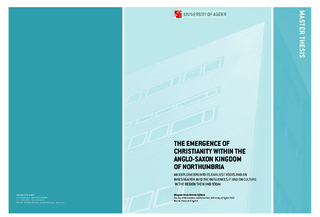| dc.description.abstract | This thesis commences with a description of Pre-Roman and Roman Britain, to
identify the people who lived in Northumbria and their background. The description then
progresses with an explanation about the withdrawal of the Romans, and the state of affairs
they left behind, giving also a reason for the arrival of the Anglo-Saxons.
Once this is established, the scene which the Anglo-Saxons meet on their arrival is
depicted, and their subsequent settlement recounted. The Anglo-Saxons were a warlike
people, so their belligerent activities suppressing the Celts, and the campaigning between
themselves and the Anglo-Saxon kingdoms for supremacy, are disclosed, too.
Before progressing to the conversion of the Anglo-Saxons to Christianity, it was
necessary to divulge the kind of religion, customs, and culture they already possessed. The
competition for lordship involved a high moral code of heroism, giving the poets material for
their verse, so the use of heroic poetry is mentioned, too. The various attempts to convert the
Anglo-Saxons are then described, and the role of Irish and Roman missionaries recorded.
The conversion of Anglo-Saxons to Christianity in the early seventh century coincided
with the meeting of two traditions of Christianity in Northumbria, Celtic and Roman, which
resulted in a church synod. The report on the Synod of Whitby occurs in the middle of this
thesis, which is very appropriate. The decision of the Synod resulted in an important turning
point within the Northumbrian Church, which involved conformity and cultural changes, too.
By far the most important development was the establishment of early Christian
monasteries and other religious sites. The Northumbrian Church consisted of only a few great
monasteries, but despite this disadvantage, these centres of learning succeeded in spreading
literacy and education, and producing literature of a most incredible quality. An account about
their founders and their daily lives is supplied, together with examples of some of the works
that were produced. Finally, the beginnings of the parochial system are described, a
modification which would indirectly influence the unification of the Anglo-Saxon kingdoms.
A new chapter focuses on Christian spiritual life, and the cult of martyrs and saints.
Hagiographical studies of the two most prominent saints of Northumbria’s ‘Golden Age are
provided. To conclude this study, the rich and abundant legacy of Anglo- Saxon Christian
Northumbria is disclosed, and evidence of its continuing influence and impact is imparted. | en |
